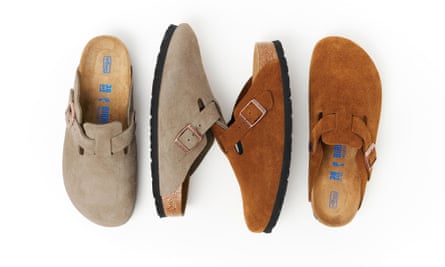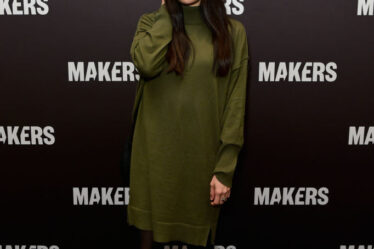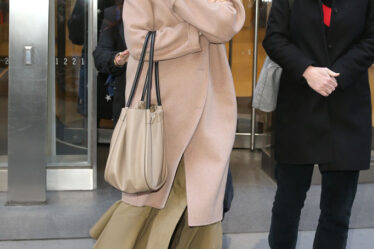
In fashion, desirable accessories are nothing new. See the Fendi baguette, the It bag of the 00s, or the recent fad for chunky dad trainers. But, as social media’s influence on style becomes more heightened, it is shoes, bags and hats that are hogging the spotlight more than ever. This is the era of the viral accessory.
JW Anderson’s pigeon bag – a clutch that is a resin model of the bird – is a popular example. It has a waiting list on the brand’s site, where it was the most-viewed item in August. It has since been carried by Sarah Jessica Parker on the set of And Just Like That … and by Sam Smith at London fashion week.
Balenciaga is another brand that has made accessories for the social media age. Its adverts recently went viral for the wrong reasons – they showed children carrying handbags that were teddy bears dressed in BDSM outfits. Previous examples of the brand’s viral items include a bag that looks like a rubbish bag but costs £1,290, and a take on the famous Ikea Frakta that cost £1,365 compared with Ikea’s 40p original.
But the viral accessory is not limited to designer fashion. This year, other items that reached fever pitch online – largely through TikTok – included the £90 Birkenstock Boston mule, and a crossbody bag from Uniqlo that cost £14.90.
Videos with #uniqlobag have 35.2m views on TikTok, and it inspired a similar design by fast fashion brand Shein. The desire for the Bostons this year was so heightened that resellers were selling them for inflated prices. In October, the New York Times reported on a consumer buying a pair for $330 (£271), compared with the RRP of $160 (£131).
In their report for the third quarter of 2022, fashion search engine Lyst noted that eight of the 10 most sought after items were accessories – from the Miu Miu ballet flats which saw a 1,100% spike in searches, to the Birkenstock Boston. This is set to continue. In the catwalk collections for spring/summer 2023, bags including crystal teddybear bags (Gucci) and a doll’s house (Louis Vuitton) are already gaining buzz, and elbow-length gloves look set to be a trend.
“Accessories have become a world of their own as opposed to just a complimentary offering to ready-to-wear,” says Libby Page, the market director at Net-a-Porter. “For the autumn/winter season alone, we significantly increased our assortment of bags, shoes and accessories by 65% due to high demand from customers.”
Resale app Depop reports that 80% of its shoppers say social media is the source of their inspiration in part because secondhand items are more affordable. “The cost of living crisis is impacting shopping habits across the nation, with many of us having less disposable income to spend on replenishing our wardrobe,” says Depop’s trends manager, Agustina Panzoni.
Designer accessories are a savvy choice – they are cheaper, and a more affordable entry into luxury brands. They are also a way to display your fashion prowess even if the outfit they are worn with is unremarkable. “We’re seeing more and more shoppers trial a trend through accessories before committing to purchase higher priced wardrobe staples,” says Panzoni. Vintage Fendi baguette bags are particularly popular – with searches increasing 2,600% this year.
Biz Sherbert, the culture editor at The Digital Fairy brand consultancy, says an accessories-first approach makes sense in the social media age. “They can act as like a prop in your photo,” she says. “and take on new forms in terms of what they represent [when seen] online.”
Part of the success of these accessories may be that they have something of a cartoonish quality – which plays out well in that very online end of visual culture, the meme. In 2020, it was estimated that at least 1m were shared on Instagram every day. They are a way to show we are in on the joke, and the news cycle. Fashion has long been part of meme culture – with everything from Kim Kardashian’s Met gala dress to Rihanna’s arrival at a Dior show turned into one.
Wearing an accessory seen in a meme – or one that is asking for a meme – is perhaps the next step of this connection. “Memes can really take a kind of innocuous object and form a full identity of the person around it,” says Sherbert. “It can be really interesting, entertaining and silly as well.”
Hey Reilly has an Instagram account dedicated to creating fashion memes, and has noticed the influence of meme culture on accessories. “This accessories trend is born of memes, [and there is also] none too subtly fishing to be memed.” Digital disruptors and Insta creatives shrink or supersize latest trends on celebs for lols, then we see designers offering extra extra large coats and shoes or teeny tiny handbags,” he says.
This style cannibalism will likely only increase. Even as the focus of social media moves away from Instagram, the power of the statement accessory still holds. “[That’s especially true] in something like BeReal,” says Sherbert of the “anti-Instagram” app that sends users a prompt to post pictures wherever they are once a day. “The photos are kind of weird and blurry. No one can see what outfit you’re wearing but a distinctive accessory stands out.”
Reilly is cynical about this trend suggesting accessories designed for a meme “take some of the critical sting out of an idea”. He points to an Instagram post of a French stick by Silvia Fendi, as a nod to the brand’s famous Baguette bag. “It’s fashion and [social media] eating themselves,” he says. Balenciaga’s teddy bear adverts, designed to be shared online, also suggests a brand’s quest to secure that viral accessory moment can sometimes go too far.



